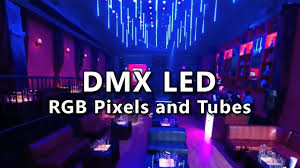DMX pixel tubes, also known as DMX pixel bars or pixel tubes, are lighting fixtures that use the DMX (Digital Multiplex) protocol to control individual pixels or sections along the length of the tube. Here's how they typically work:

-
Structure: A DMX pixel tube consists of a long, cylindrical housing containing multiple LED pixels arranged along its length. These pixels can be RGB (Red, Green, Blue) LEDs or RGBW (Red, Green, Blue, White) LEDs, allowing for a wide range of color options.
-
DMX Control: DMX is a digital communication protocol commonly used in the lighting industry to control lighting fixtures. Each DMX pixel tube has a DMX input and output connector. The DMX signal is daisy-chained from one fixture to the next using standard DMX cables.
-
Pixel Mapping: Each pixel or section along the length of the tube corresponds to a specific DMX channel or channels. For example, if a pixel tube has 100 pixels and each pixel can be individually controlled for color, it may require 300 DMX channels (100 pixels x 3 color channels per pixel).
-
DMX Controller: To control DMX pixel tubes, you need a DMX controller capable of outputting the necessary number of DMX channels. This controller can be a hardware console, a software-based controller running on a computer, or even a dedicated lighting app on a smartphone or tablet.
-
Programming: Using the DMX controller, you can program various lighting effects and sequences for the pixel tubes. This programming typically involves assigning DMX values to control parameters such as color, intensity, and effects for each pixel or section of the tube.
-
Playback: Once programmed, the DMX controller sends the corresponding DMX signal to the pixel tubes, causing them to display the programmed lighting effects. These effects can range from simple static colors to dynamic color-changing patterns, chases, and animations.
-
Integration: DMX pixel tubes can be integrated into larger lighting setups alongside other DMX-compatible fixtures such as moving heads, wash lights, and strobes. This allows for synchronized lighting displays across multiple fixtures.
-
Power Supply: DMX pixel tubes require a power supply to operate the LEDs. Depending on the size and power requirements of the tubes, this power supply may be built into the fixture or provided as a separate unit.
Overall, DMX pixel tubes offer a versatile and dynamic lighting solution for various applications, including stage performances, concerts, architectural lighting, and events. They allow for precise control over individual pixels or sections, enabling creative lighting designs and effects.

